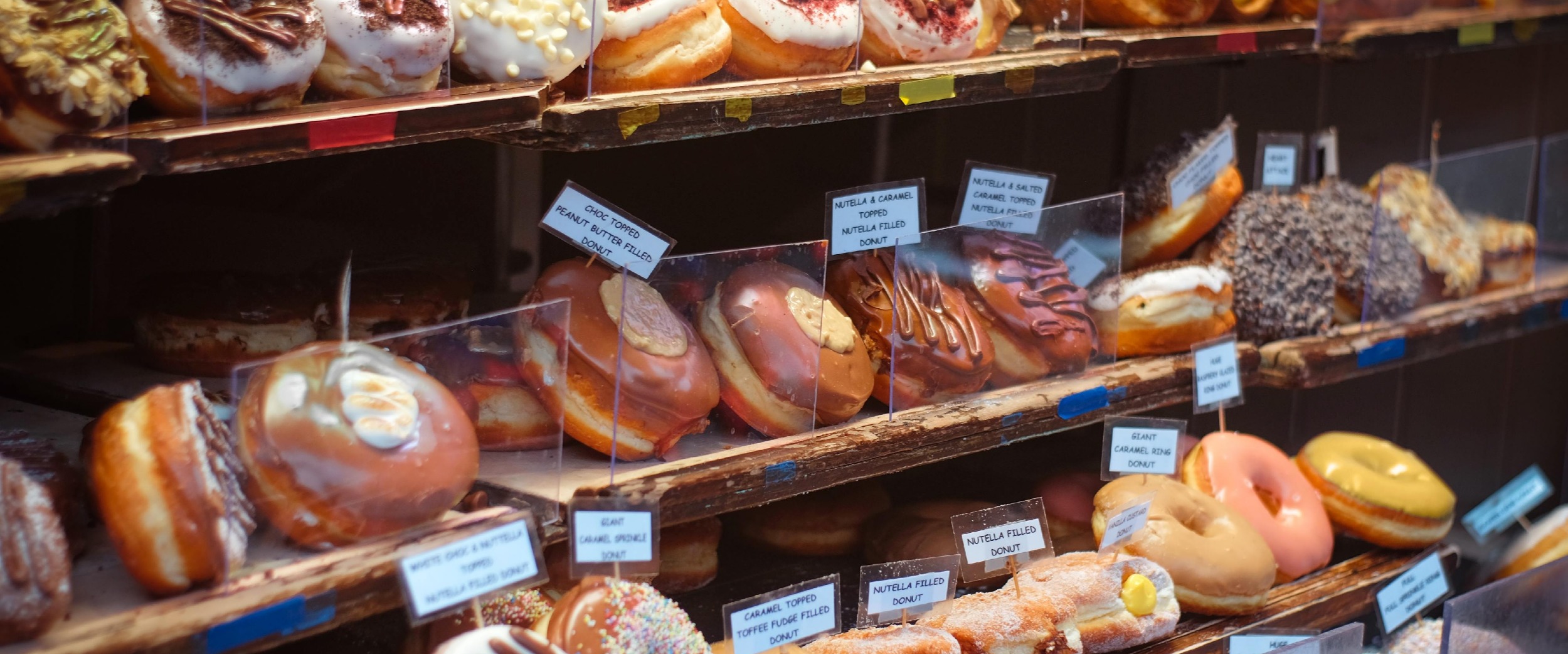Cathy Leman, MA, RD, CPT, is a registered dietitian nutritionist, certified personal trainer, nutrition therapist, blogger, speaker, and the founder of dam. mad. About BREAST CANCER®. In October 2014, after being diagnosed with Stage 1 invasive ductal carcinoma breast cancer, Cathy made it her mission to serve the breast cancer community with evidence-based recommendations and guidance. She educates, informs and inspires women to eat, exercise and practice self-care/wellbeing with confidence.
By Cathy Leman, MA, RD, CPT
Sugar, in all its stark white, sparkling glory is an enormously popular, widely misunderstood, and a hotly debated topic in the breast cancer world. Rarely a week passes when I don’t hear or read “Sugar feeds breast cancer”, proclaimed with absolute certainty. People accept this declaration as truth, yet I ask; does it really?
The annual October convergence of breast cancer awareness with the sugar-overload of Halloween is the perfect time for sharing sweet words of wisdom about the ubiquitous ingredient we love to hate and debate.
First, let’s make one thing clear. When I write about breast cancer nutrition, foods or diets, the first thing I do is hit the research. I’m a dietitian. I have a Bachelor of Science degree in nutrition. I will say this until the day I leave this earth – nutrition is a science, not an opinion. While everyone rightly deserves to have their own opinion about nutrition (and foods and diets), I’m not “everyone.” I’m a nutrition professional AND a breast cancer survivor.
I have a professional, ethical obligation to write from the science1, and a personal mission and purpose to develop and share trusted nutrition information that serves my breast cancer community. I take both very seriously.
I asked myself what non-sugar-coated information would be most helpful for someone newly diagnosed, feeling frustrated and confused because they couldn’t find consistent answers to their questions about sugar and diet.
Here’s what I came up with:
- Will sugar really kill me?
- Ss sugar really horrible?
- Does sugar cause cancer?
- Does sugar make cancer grow?
- Should I cut out sugar completely?
- Does sugar affect the chances of recurrence?
- What amount of sugar can I eat and still be as healthy as possible going into treatment?
I then thought about the person who perhaps doesn’t give a rat’s ass about the science, feels overwhelmed and impatient by the idea of sifting through pages of conflicting online information and believes doing so would be about as effective as herding cats, and just wants to be told what to do.
If that’s YOU. . .
Start Here.
There are literally hundreds of studies and reams of information on sugar and breast cancer; there’s no way I could possibly cover it all in this single blog, but for the purpose of this article, here are my goals:
- Provide a quick “Carbohydrates 101”
- Give you a tiny taste of the current research/science
- Provide a sweet guide to help you put this information into practice
A Little Carbohydrate Background
Carbohydrates are one of three macronutrients (protein and fat are the other two) necessary in a diet to support energy, growth, and life, and include a wide range of starches, sugars and fiber. Some sugars are naturally occurring, like the sugar found in fruits, vegetables, whole grains, and some dairy products. Other sugars, such as high fructose corn syrup, are produced commercially and then added to foods. “Carbohydrate” is a category that includes a wide range of starches, sugars (both naturally occurring and commercially produced), and fiber.
There are many types of sugar, which are classified by chemists according to their chemical structure i.e. monosaccharides (single, simple sugars) and disaccharides (two simple sugars joined together), and several forms of sugar, i.e. glucose, fructose and galactose, which come together to create even more forms of sugar, like the lactose in milk (glucose + galactose), and the maltose found in molasses (glucose + glucose.)
The concern for newly diagnosed and metastatic patients is that sugar “feeds” cancer, making it grow faster and uncontrollably, hastening its potential and/or further spread throughout the body. For patients undergoing treatment, there may be concern that sugar interferes with chemo and/or radiation. For women without a breast cancer diagnosis or are NED (no evidence of disease) post-treatment, the concern is that sugar will cause an initial cancer diagnosis or a recurrence.
A (Very Small) Taste of The Current Research
- Including “naturally occurring” sugars in your diet from fruits, vegetables, whole grains and dairy (i.e. plain cow’s milk versus chocolate or other flavored milks which have added sugar) is an eating pattern you can feel comfortable about. These naturally sweet (or savory whole grain) foods not only provide energy-rich carbohydrates, they’re loaded with vitamins, minerals, fiber, antioxidants, and phytochemicals versus only the empty calories of most added sugars.2
- Sugar does indeed feed cancer cells, as well as all of your other cells. Every cell in your body uses glucose (the broken-down form of carbohydrate) for energy. Even on a no/low carbohydrate diet, your body transforms protein and fat into usable glucose (blood sugar) to support the function of your brain (which can use only carbohydrate for energy) and all your other tissues.
- Because cancer cells are especially “hungry and hyperactive,” they consume glucose more quickly than non-cancerous cells. With the help of a radioactive compound very similar to glucose that allows detection of the metabolic activity (hungriness and hyperness) of cancer cells, medical professionals are able to see this phenomenon during a PET (Positron Emission Tomography) scan.
- Cells use sugar like cars use gasoline. Normal cells use a reasonable amount of gas, but because cancer cells divide at faster rates than normal cells, they’re gas (sugar) guzzlers.3
- Compelling epidemiologic studies have shown that dietary sugar intake has a significant impact on the development of breast cancer, but the data is inconsistent and the mechanism is unclear. One proposed mechanism for how sugar impacts breast cancer is through inflammation (obesity is a strong driver of systemic inflammation.) In one study, sugar did accelerate and promote the development of breast cancer in mice fed the equivalent of the average sugar consumption by the American population – 70 pounds/person/year according to this particular study – through changes in metabolic signaling pathways and the expression and production of certain proteins linked to the inflammatory response. Takeaway: sugar did not directly cause breast cancer, rather, it exerted influence on a particular signal and pathway involved in promoting its development. And, this was a mouse study. Mice are not humans.4
- Another very small study, again, done on mice and only certain types of breast cancer cells in culture and for select chemo medications, indicated that sugar may interfere with the body’s response to and effectiveness of chemotherapy, calling for further investigation to achieve definite outcomes and practices for real-life applications.5
- When carbohydrates are eaten, the body increases its output of insulin to help return post-meal blood sugar levels to normal. Failure of insulin levels to return to normal after the blood sugar is cleared indicates insulin resistance and high levels of insulin remaining in the blood. Insulin resistance can result from obesity and inactivity; insulin resistance is associated with higher breast cancer recurrence risk.6
A SWEET Guide To Help You Navigate Sugar Challenges
- Aim to keep your added sugar intake to 10% or less of the total calories you eat daily. For example, if you eat 2,000 calories per day, all the calories you eat from added sugar for the entire day would equal 200 calories. Remember, that’s calories not grams, there’s a difference (see below.)
- Added sugars are found in: candy, cookies, cake, pie, brownies, muffins, sweet rolls and pastry, ice cream, sorbet, gelato, sweetened beverages like juice-drinks, fruit punch, sports drinks, sweetened iced tea, bottled smoothies, soda and coffee drinks, cereals, some breads, ketchup, barbeque sauce, spaghetti and tomato sauces, flavored milks (plant-based and cow), flavored yogurt, protein and cereal bars, salad dressing, canned baked beans (this is NOT a definitive list – check ingredient labels!)
- 1 gram of sugar has 4 calories. If a food label shows 5 grams of sugar in one serving, that food gives you 20 calories of sugar (5 grams x 4 calories.)
- When choosing packaged foods, look at the ingredients label. If you see any of the following terms, you’ll know there is added sugar: brown sugar, corn sweetener, corn syrup, dextrose, fructose, glucose, high-fructose corn syrup, honey, invert sugar, malt syrup, maltose, molasses, raw sugar, sucrose, trehalose, turbinado sugar
What 200 Calories/Day of Added Sugar Looks Like
Breakfast
- 1 packet instant maple and brown sugar oatmeal; 12 grams sugar (48 calories from sugar)
- 1 cup vanilla almond milk; 13 grams sugar (52 calories from sugar)
Lunch
- 2 tablespoons honey Dijon dressing; 5 grams sugar (20 calories from sugar)
- Mixed greens salad with 1 ounce candied walnuts and 2 tablespoons dried cranberries; 9 grams sugar + 13 grams sugar (88 calories from sugar)
Surprise! You’re already at 208 calories from sugar and your day’s not even over. This example isn’t meant to prevent you from eating any added sugar, rather, to give you an idea of how quickly added sugars can creep in without you being aware. This is an easy fix!
Fix It Like This. . .
Choose plain instant oatmeal and add 1 teaspoon honey, use plain (no-sugar-added) vanilla almond milk. Add olive oil and balsamic vinegar to your salad, raisins vs dried cranberries (raisins have natural vs. added sugar) and non-sugared, toasted walnuts.
Photo by Viktor Forgacs on Unsplash







